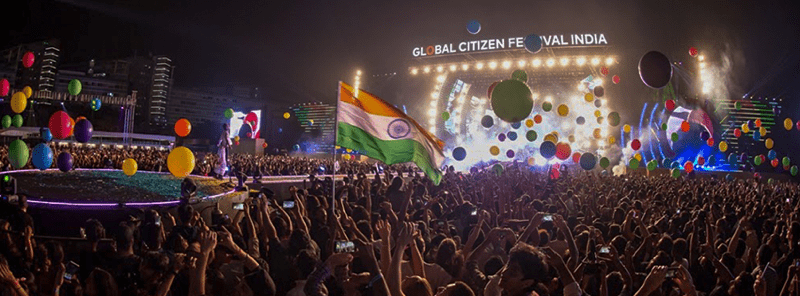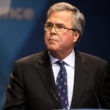The lights dimmed and the deafening sound of 80,000 people cheering enveloped concertgoers as Indian Prime Minister Narendra Modi appeared on a massive screen behind the stage. In a masterful speech, albeit one delivered in halting English, Modi detailed the achievements of his two-year-old administration. Throughout, of course, were plugs for his Android app and a slew of jokes about his recently implemented, and widely criticized, demonetization policy. He ended with a quote from Bob Dylan’s “Times They Are A’Changing,” an ironic choice for a leader whose Minister of State for Culture and Tourism has promised to purge India of Western “cultural pollution.”
The audience ate it up, and the Mumbai Metropolitan Region Development Authority (MMRDA) grounds rang with chants of “Modi! Modi!” While the scene could have come straight from one of Modi’s many energetic post-election rallies in India and abroad, this was no political rally. Modi was here for the first Indian Global Citizen Festival, an international mass advocacy movement that seeks to end extreme poverty by harnessing the power of pop culture and social media. One can only wonder what went through Global Citizen co-founder Hugh Evans’s head as he saw his internationalist platform for change become a propaganda vehicle for a Hindu nationalist leader and strongman. Coldplay, the festival’s main attraction, may have been making their own stance clear when they opened their set with an excerpt from Charlie Chaplin’s speech in The Great Dictator.
The Global Citizen Festival is young, but it rose to prominence fast. Evans founded the Global Poverty Project in Australia in 2008, along with his former university classmates Simon Moss and Wei Soo. The project started as an international educational and advocacy organization, with the aim to end extreme poverty worldwide by 2030. Global Citizen was, at first, one of many initiatives the Global Poverty Project offered—since then, it’s become the project’s main focus. As Moss is quick to note, “the world has the resources and know-how to end extreme poverty. It only persists because we as a society have made political choices that have prioritized other issues.”
“That’s why our campaigning model focuses on getting citizens to use their voices to get our political and business leaders to play their part in tackling the issues,” he continues.
Through its website and festivals, Global Citizen seeks to bring young music fans together to form a global advocacy movement. Tickets for the concerts are ostensibly free, though they do have to be earned by engaging in a series of “actions”—signing online petitions, participating in tweetstorms, and sending out email blasts in order to raise awareness about specific issues. Since the Global Citizen festival started in New York in 2012, hundreds of thousands of people have taken part in such “actions” in return for a chance to see big-ticket acts like Beyoncé, Stevie Wonder, and Metallica. Governments and corporations saw the platform’s promise early on, and have since made over 150 major commitments toward meeting the organization’s stated goals.
Global Citizen’s uncritical approach provides cover for the politicians, organizations, and corporations that it ostensibly wants to hold accountable.
Efforts to bring the poverty-smashing extravaganza to India began in September 2014, when Evans met Modi at a Global Citizen festival in New York City. Modi’s appearance at the festival, which was shortly after his resounding victory in India’s national elections, was a symbolic triumph for the leader, who had long been denied a U.S. visa because of his alleged involvement in the 2002 anti-Muslim pogrom in Gujarat. Despite a small hiccup involving mistaking Hugh Jackman for a Jedi, it was yet another step in the process of Modi’s rehabilitation on the international stage. After two years of deliberations, the festival travelled to Mumbai on November 19, 2016—marking its first appearance outside the United States. The rationale for bringing the event to Mumbai was, at least according to Moss, that “the Indian leadership’s support for children’s education, access to clean water, gender equality, and more is integral to achieving the Global Goals by 2030.” And with Brit mope-rockers Coldplay and American rap mogul Jay Z on the lineup, the event was an immediate hit on social media.
But despite all the hype and years of planning, the festival was racked with problems. City authorities had to shut down the road leading to the venue on the day of the event, as traffic remained gridlocked for miles around. Excited fans braved mile-long queues on foot and many complained of inadequate provisions, such as drinking water. And despite earlier promises that 80 percent of the tickets were “free,” the enclosure in front of the stage ended up being accessible only to those who had paid upwards of $350—more than half of the country’s median annual income—to get in. Meanwhile, one of the zones for free ticket holders was so far from the stage—literally across a major road—that attendees would have had an easier time watching the show on television.
Platitudes and poor performances were abundant. An assembly line of Indian film stars, politicians, and business leaders took the stage to mouth generic truisms about poverty and gender equality. There was some grumbling about one Indian performer lip-syncing; another was so off-key that I overheard an attendee say, “I wish he was lip-syncing too.” The crowd broke out of its stupor when A.R. Rahman—an Indian composer known for his work on Slumdog Millionaire—performed his hits. But the appearance of Bollywood superstars Amitabh Bachchan and Shah Rukh Khan raised desultory cheers, while retired cricketer Sachin Tendulkar inspired a chant that drowned out a speech by industrialist Ratan Tata. The crowd, it seemed, saved their energy for Jay Z and Coldplay. When the latter broke into the piano-ballad “Yellow,” it was hard to hear over the roar of 80,000 voices.
On the advocacy front, the festival solicited commitments worth $5.93 billion from the national and local governments, global NGOs, and big business conglomerates toward the Indian chapter’s three goals: sanitation, education, and gender equality. Two cities and 200 districts committed to be open-defecation free by 2017, while the state of Telangana (a state in South India that was carved out of Andhra Pradesh in 2014) committed to provide potable water to two million families. The International Finance Corporation pledged $2 billion toward promoting women entrepreneurs while the Toilet Board Coalition said it would help improve 125 million people’s access to sanitation and hygiene by 2020. Other pledges included microloans, mobile classrooms, and free meals.
There’s a celebratory air to the pronouncements of Global Citizen and its NGO partners after the event. “India was incredible on all fronts,” enthuses Moss. Parth Vasavada—one of the founders of Indian NGO Yuva Unstoppable, which has committed to put 400,000 more students into school—was still gushing when I spoke to him over the phone a week later.
“In India, every youngster wants to do something for the country, but they don’t know how to help,” he says, explaining why Global Citizen was able to generate such a buzz among India’s urban youth. “When we make doing good cool and fun, which is what Global Citizen is doing, it is really possible to mobilize them. That is why I’m a hundred percent sure that [Global Citizen] will make a difference in this country.”
Development for me, but not for thee
Admirable as these achievements are, serious questions remain about how effective they will be in achieving the project’s ultimate goal: eliminating global poverty. Many in India’s NGO and development sector—not to mention abroad—remain unconvinced. While accusations of “slacktivism” and virtue signalling can be dismissed as armchair criticism, other critiques of the Global Citizen approach are harder to ignore. One of the biggest problems is Global Citizen’s embrace of the U.N.’s Sustainable Development Goals (SDGs), which have been described as “a high school wish-list for how to save the world,” “worse than useless,” and “senseless, dreamy, garbled.” These goals in turn are based on the eight Millennium Development Goals announced in 2000, when the global North decided for the rest of us that neoliberalism was the best way to fix the world. The MDGs expired in 2015 and are considered to have been largely ineffectual. The SDGs continue in the same vein, listing out 17 lofty “Global Goals” for the international community to achieve by 2030. One glaring problem is that their drafters continue to assert that all we need is more industrial growth—175 times the current global GDP. To put that into perspective, for the world’s poorest to earn $5 a day, the global per capita income would have to be $1.3 million. No, that is not a calculation error. That’s just an indicator of the glaring inequalities in the global economy, inequalities that the SDGs do nothing to address. And even that laughably impracticable goal would take at least 100 years according to the most optimistic predictions. Considering we’re already overshooting the Earth’s biocapacity by about 50 percent a year, to call this “sustainable” development is a cruel joke at best.
“GDP growth is causing an environmental crisis, so it’s just not possible for that to be the answer,” says James North, a Bangalore-based digital consultant who has previously worked with Greenpeace and TheRules.org. “So the better way to look at ending poverty is redistribution rather than growth. But the SDGs shy away from looking at redistribution because they’re within the neoliberal framework and redistribution is a dirty word there.”
‘If we’re not changing the culture of activism, and we’re staying in that safe space, then Global Citizen continues to pander to a model of activism that already exists and dominates here.’
Both the SDGs and Global Citizen present us with a depoliticized picture of poverty, where living in a state of want is a natural phenomenon rather than one born out of centuries of crushing political and economic decisions. It asks no hard questions about those who have benefited—and continue to benefit—from a global economic system that has led to historic levels of inequality. For Global Citizen, poverty exists because we have yet to properly apply our brains and our wallets to solving the problem. This is a continuation of the technocratic approach that has dominated the global “development” sector for decades—one that leaves no space for grappling with political or ideological questions.
“You’ve got the whole Francis Fukuyama idea of the end of history, that ideology must be kept out of development work,” says North. “Which is a profoundly ideological position itself, it’s just that they can’t see the ideology within which they operate.”
Global Citizen’s uncritical approach provides cover for the politicians, organizations, and corporations that it ostensibly wants to hold accountable. It is deeply linked to the World Bank and the International Monetary Fund—both of which are key to enforcing a neoliberal development agenda—while its corporate partners, such as Google and Citibank, have a long history of tax avoidance and fraud. In India, the organization has teamed up with The Global Education and Leadership Foundation, whose chairman, Shiv Khemka, moonlights as a middleman for Indo-Russian arms deals. One of its partners, Unilever, was recently forced to settle over a 15-year-old case of mercury poisoning after years of protests and a viral rap song. Another partner, PepsiCo, has been a frequent target of protests due to its factories drawing massive quantities of groundwater in water-parched areas. The fact that Global Citizen does not deign to fret over such poor business practices, makes it attractive to these corporations, many of which see it as a way to fulfill their corporate social responsibility targets.
Similarly, Global Citizen’s assertion that its goals transcend “partisan politics” has allowed the Indian government to brand itself as socially conscious without having to answer any tough questions about its more controversial and destructive policies. On the face of it, the Indian government’s dilution of environmental regulations, its demonetization policy (which has disproportionately affected the poor), and its religiously motivated move to deny undernourished kids eggs all fly in the face of Global Citizen’s goals. Additionally, most of the commitments made by the Indian government are not “new” commitments at all. Many reiterate pledges made as a part of Modi’s flagship Swachh Bharat (Clean India) campaign, which launched two years ago. Global Citizen merely serves as a global branding exercise with negligible costs.
“They’re swallowing so much state propaganda,” says Aruna Chandrasekhar, a Bangalore-based independent researcher and activist who previously worked with Amnesty International. “Take Telangana’s commitment to provide potable water to two million people, where does the water for that come from? Will it be the Polavaram dam? How many will be displaced because of it?”
For Chandrasekhar, Global Citizen’s primary flaw is that it does not stray from the safe, palatable, and high-optics issues that have long been fashionable among the humanitarian aid community. “They’re not talking about caste; they’re not going to talk about environmental rights,” she says. “If we’re not changing the culture of activism, and we’re staying in that safe space, then Global Citizen continues to pander to a model of activism that already exists and dominates here.”
There’s no denying the importance of Global Citizen as a platform for mobilizing young people and raising awareness about crucial issues, or the potential impact of the commitments it has secured. But its failure to ask tough questions and to call out the economic system and policies that have led to one of the world’s sharpest rises in income inequality over the last two decades means that its efforts are likely to be a flashy, feel-good Band-Aid applied to a gaping wound. Despite its lofty goals and breathless rhetoric of “upliftment,” Global Citizen seems like the millennial equivalent of a black-tie charity gala.
In other words, it offers the same self-satisfied back-slapping, just without the black ties, or the charity. From this perspective, the lasting image from November’s festival is not of Modi, or of Chris Martin running around the stage waving the Indian flag. It’s one from earlier in the day: of a line of rich Indian kids with sharp clothes and even sharper accents looking the other way as a pre-teen rag-picker shambles by, picking up the trash they had unceremoniously dumped just moments before. In an event replete with ironies, that was the biggest one of all.
Bhanuj Kappal is a freelance writer based in Mumbai who writes about music, art, and political culture.
Correction: This article has been updated to reflect that the song Modi quoted was “Times They Are A’Changing,” not “Blowin’ In The Wind.”







0 Comments